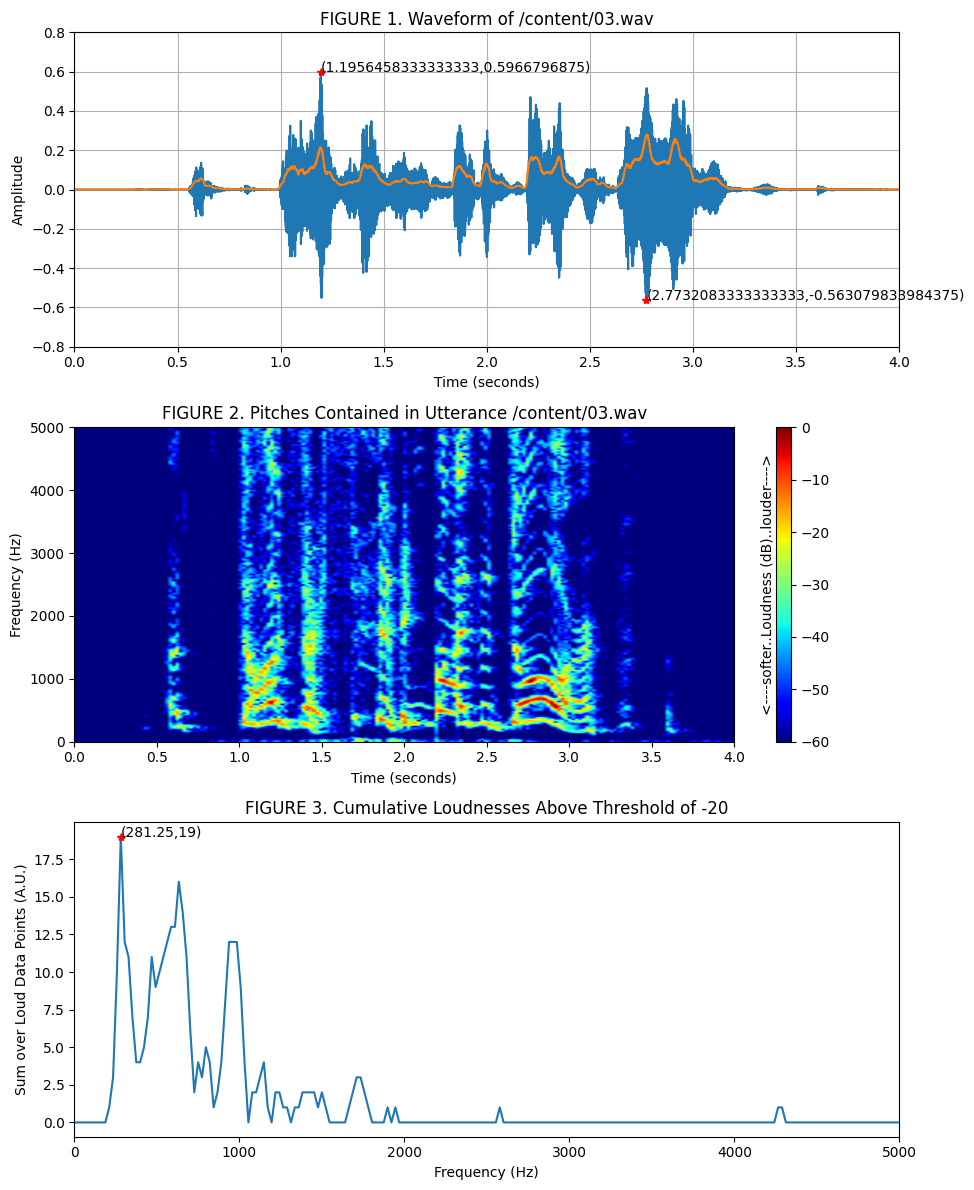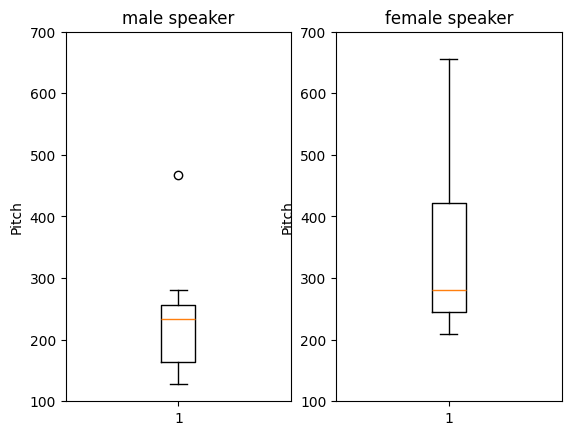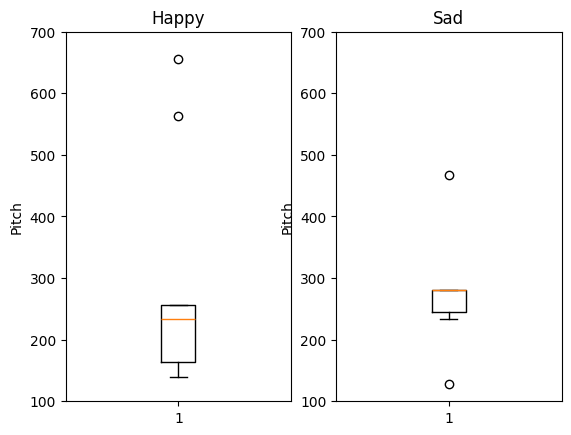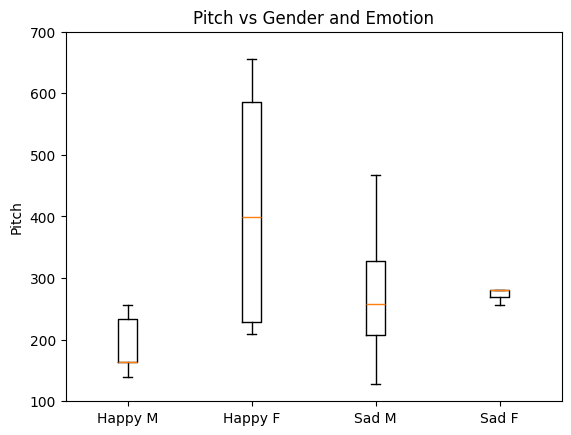File 03.wavFinal Project
Overlapping Audio Features Determine Emotion and Gender Classification in Speech
Emily Graber
Abstract
Cochlear implant users often have difficulty distinguishing the gender and emotion of the person they are talking to on the phone when no visual cues are present. They feel a lack of control that builds over time. Doctors and cochlear implant manufacturers would like to find a solution to assist their patients’ and customers. Part of the trouble is that the microchips that do processing on the implants are only able to process very basic features of the audio, however the features that enocode emotion and gender cues may not be basic features. Here we will try to understand what might be going wrong on the audio chips. In a first step, we will take a computational approach to analyzing several audio files that contain sentences expressed with happiness and sadness by male and female speakers. The most salient pitch and amplitude were extracted from each file. Using only these two features to classify four categories of happy female, happy male, sad female, and sad male, the sentences are not correctly classified. This suggests that more than pitch and amplitude may be need to be processed in order to accurately classifying gender and emotion. Further development of audio processing algorithms that can capture more than pitch and amplitude would likely be helpful to untangle the differences in vocal samples and aid cochlear implant users.
Hypothesis
- Basic audio features of pitch and amplitude are not sufficient to accurately classify audio samples
Methods
Data
Audio samples containing happy and sad speech from male and female speakers were downloaded from the Ryerson Audio-Visual Database of Emotional Speech and Song (RAVDESS). The database overall contains 7356 files of 24 professional actors (12 female, 12 male), speaking two sentences with a number of different emotions and intensities. Only the happy and sad data from the actors were analyzed. These emotions were selected because they are typically easy to identity for normal-hearing subjects without using any visual cues. For cochlear implant users, identification based on audio alone is much more challenging.
Preprocessing Steps
The wave files from the dataset were downloaded and audio transformations were applied to extract the most salient amplitude and pitch from each file. One audio file is shown below along with transformations that facilitated the pitch and amplitude extraction process.
The most salient amplitude was read off of the raw audio waveform (Figure 1) while the most salient pitch was read off of a truncated spectral representation of the audio (Figure 3).

The extracted pitch and amplitude data were stored in a new dataset. The original speaker gender and emotion were also recorded ito the new dataset. The new data set was then further processed.
filenum max_abs_amplitude most_common_freq vocal_gender vocal_emotion
0 1 0.1270 128 0 1
1 2 0.2402 257 1 1
2 3 0.5960 281 0 1
3 4 0.2620 281 1 1
4 5 0.1550 234 0 1
5 8 0.6000 281 1 1
6 9 0.2000 468 0 1
7 15 0.1000 234 0 0
8 16 0.1900 234 1 0
9 17 0.3240 140 0 0
10 18 0.0420 656 1 0
11 19 0.0250 164 0 0
12 20 0.1430 563 1 0
13 21 0.1600 257 0 0
14 22 0.0680 210 1 0
15 23 0.0570 164 0 0Processing Steps
- TODO: describe major steps that you do to make sense of the data. Be specific enough so that someone could replicate your work in a different programming language. This means that you should not dictate what functions to use, rather the concepts to use.
- Ideally this will be a story with multiple steps, e.g. raw data inspection, then filtering, then averaging, then comparing
- Optional: Don’t forget about the possibility of doing correlation, linear regression, k-means clustering, or hypothesis testing
Purpose
- TODO: Explain why doing the steps above will answer your question
Results and Discussion
- TODO: visualize as many of the previously-mentioned steps as possible. Label everything. Break up this markdown cell as needed with code cells that generate plots. Use python to generate plots
- TODO: state the mean and standard deviation in text for each major step that you take. Use python to compute those statistics
- TODO: for each plot, either right before or right after, describe the plot without interpretation. Just describe what you see, any relevant colors or categories, etc.
- TODO: after you describe the plot, interpret it. What does it mean and how does it connect back to your question?
- TODO: before going to the next step, say why you are going to the next step, and how it connects back to your question or logically follows from the previous step.



Conclusions
- TODO: repeat your main findings and why they matter
- TODO: state the answer to your question
- TODO: state any limitations or problems with the current results
- TODO: overall, state how your result informs or helps others
Reference
- TODO: cite one scholarly article that relates to your topic/methods/results
Appendix 1
- This section documents your technical knowledge that is not part of your research story
- TODO: describe the key features of your data, the type, the dimensions, and how you know the type and dimension
- TODO: document the pre written python libraries that were used.
- TODO: describe the key technical elements in your data visualizations, such as the type of plots, settings for the axes, symbol choices, color choices, legend usage, etc.
Appendix 2
- TODO: explain logical filtering using an example from this course
- TODO: explain standard deviation using an example from this course